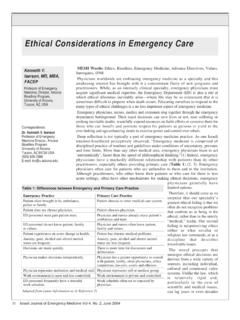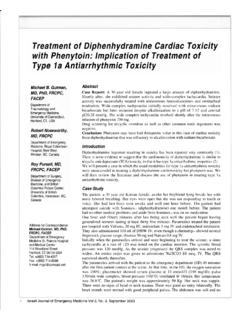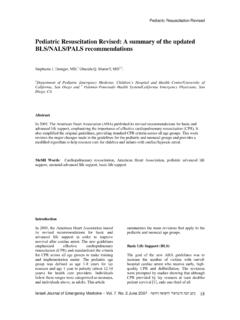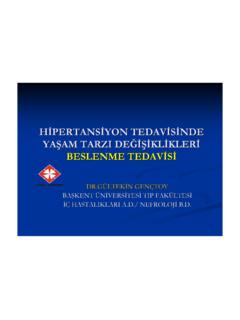Transcription of CORTICOSTEROIDS FOR ACUTE TRAUMATIC …
1 Evidence-Based Emergency Medicine: CORTICOSTEROIDS FOR ACUTE TRAUMATIC BRAIN. INJURY. Adam Kennah, MD*, Comilla Sasson, MD*, Barry Diner, MD^. * AK, CS: Resident Department of Emergency Medicine, Emory University ^ BD: Assistant Professor, Department of Emergency Medicine, Emory University Abstract: This is a systematic review abstract, which will be a regular feature of the Israeli Journal of Emergency Medicine) series. Each features an abstract of a systematic review from the Cochrane Database of Systematic Reviews and a commentary by an emergency physician knowledgeable in the subject area. Systemic Review Source: The source for this systematic review abstract is: Alderson, P. and Roberts, I. CORTICOSTEROIDS for ACUTE TRAUMATIC brain injury. (Cochrane Review). In: The Cochrane Library, Volume 2, 2005.
2 Cochrane Systematic Review Author Contact: Dr. Phil Anderson, MD. Associate Guidelines Programme Director National Institutes of Clinical Excellence London, UK. MesH Words: Trauma, Brain Injury, CORTICOSTEROIDS Objective: Data Source: To quantify the effect of CORTICOSTEROIDS on The following databases were searched: mortality and morbidity in patients with ACUTE Cochrane Central Register of Controlled Trials TRAUMATIC brain injury (TBI), while examining (CENTRAL), MEDLINE, EMBASE and the incidence of adverse side effects or specialized database searches. Researchers complications and economic effects. conducting trials within this field were also Israeli Journal of Emergency Medicine Vol. 5, No. 3 July 2005 - 2. CORTICOSTEROIDS for Head Injury contacted. The last search was conducted in Main Results: October 2004.
3 20 trials were identified with 12303 randomized Study Selection: patients. 17 trials included risk of death using All randomized controlled trials which utilized corticosteroid in TBI patients. The largest trial CORTICOSTEROIDS versus any control in the setting was the CRASH trial (which had approximately of ACUTE TBI were included. Patients of all ages 80% of the total number of patients). The with clinically diagnosed TBI of all severities relative risk of death was (95% CI who were treated with CORTICOSTEROIDS ) in the CRASH study, which showed a (glucocorticoids utilized most often- statistically significant increase in mortality with prednisolone, betamethasone, cortisone, steroids. dexamethasone, hydrocortisone, methylprednisolone, prednisone and The pooled relative risk was (CI ).)
4 Triamcinolone). within 7 days of injury were for the 9 trials that reported death or severe considered eligible. Any trials utilizing disability. The CRASH trial was not included as CORTICOSTEROIDS within 7 days irrespective of the these results were not published at the time of route or duration were included, regardless of this review. Infection rates which were included any other treatment interventions. The primary in 5 trials had a relative risk of (CI outcomes that were examined were all cause case ). This showed no major change in risk of fatality, any valid measurement of neurological infection. The 10 trials which examined functioning, quality of life and economic impact. gastrointestinal bleed did not show a significant The primary adverse side effects examined were effect of CORTICOSTEROIDS on the number of GI.
5 Numbers of infections and significant bleeds with a relative risk of (CI ). gastrointestinal bleeds. The CRASH study has been the major study Data Extraction: looked at by the reviewers. They acknowledge that more information will be extracted, once the Two reviewers initially did the first review, with data is fully completed and available. Given the an updated search in October 2004. The data fact that the CRASH study was terminated early extracted from each trial included: strategy for secondary to the negative impact of allocation concealment, number of randomized CORTICOSTEROIDS on survival, the results of patients, length of follow-up and number lost to included here have been duly noted. The follow-up. The reviewers believed that reviewers believe that the large number of allocation concealment was integral to the participants, and the quality of the CRASH trial quality of information, so the Schulz scale was have guided the conclusions in this review.
6 Used to assign quality- A being best, C being poorest.(1) If the method for allocation Although the investigators wanted to look at concealment was not well stated, the reviewers economic impact of CORTICOSTEROIDS , there was no contacted the researchers personally to clarify. data gathered in any of the trials. Scores were then compared and differences resolved by discussion. A fixed effects model Conclusion: was used to calculate dichotomous variables that were reported as relative risks and 95% Given the extent of data in the CRASH trial, Confidence Intervals used in studies determined CORTICOSTEROIDS appear to increase mortality in the not to have statistically significant heterogeneity. setting of ACUTE TBI. There is no significant effect on infections or gastrointestinal bleeds in In the update in 2004, the staff included the these same patients.
7 As such, patients should not results of the CRASH trial that were then be given steroids in the setting of isolated ACUTE available. Other than the data from the CRASH TRAUMATIC brain injury. trial, no other trials were found or included. The CRASH trial addition introduced significant Commentary: heterogeneity when using the fixed-effect risks ratio model to look at pooled data. TRAUMATIC brain injury (TBI) is a major public Subsequently, the results of all of the trials were health problem, accounting for one-third of all not pooled. TRAUMATIC deaths. A study completed by the Israeli Journal of Emergency Medicine Vol. 5, No. 3 July 2005 - 3. CORTICOSTEROIDS for Head Injury Centers for Disease Control (CDC) in 2001 (CI of to ). A 15 % chance that estimates that million people sustain a TBI in CORTICOSTEROIDS would improve survival but an the United States each year.
8 Of these, 50,000 8% chance it would increase death. This will die of their injuries, while another 90,000 prompted a much larger study (CRASH) with Dr will survive with permanent disabilities (2). A Roberts participating as one of the Primary hospital in northern Israel reported a similar Investigators. annual incidence of 25 TBI's per 100,000 (3). The direct medical cost associated with TBI in This updated review summarizes the role of the United States has been estimated at $4 billion CORTICOSTEROIDS in TBI. The review includes 20. dollars (4). randomized controlled trials for a total of 12,303. subjects. Seventeen trials reported the effect of In both the United States and Israel, falls were CORTICOSTEROIDS on mortality. The results ranged the most common cause of TBI, followed closely wildly, with relative risks from to by motor vehicle collisions (2,4).
9 Motor vehicle There was significant heterogeneity that could collisions were the leading cause of TBI-related not be explained with a sensitive analysis that deaths in the United States for decades, but removed trials based on adequate allocation improvements in vehicle safety have reduced concealment and therefore the results were not mortality rates 42% from 1979 to 1992. In 1990, pooled. It is unfortunate, that the authors did not firearms surpassed motor vehicles as the leading expand their sensitive analysis using a widely cause of TBI-associated deaths (5). However, in accepted quality tool such as the Jadad criteria. the rapidly motorizing Asian countries the rates (8) Of the 17 trails, only two demonstrated of vehicle associated deaths is steadily increasing statistical significance.
10 The Faupel study (1976), (6). which compared low dose and high dose dexamethasone to placebo in 95 patients, came Despite the massive clinical and economic out in favor of CORTICOSTEROIDS (RR ; 95% CI. impact of TBI, few proven beneficial treatments to ) and the treatment of 4 patients exist. In recent years, a number of promising would translate into one saved life (NNT 4) . therapies based on positive preclinical data have However, the larger and more methodologically fizzled in clinical trials. Glutamate antagonists sound CRASH trial (2004) reported a significant (Selfotel, Cerestat, D-CPP-ene), free radical increase in mortality (RR ; 95% CI to scavengers (PEG-Orgatine), and IGF-1 with ) with the number needed to harm of 31. growth hormone all failed to show statistically The CRASH trial compared 48 hours of high significant improvement in clinical trials.










